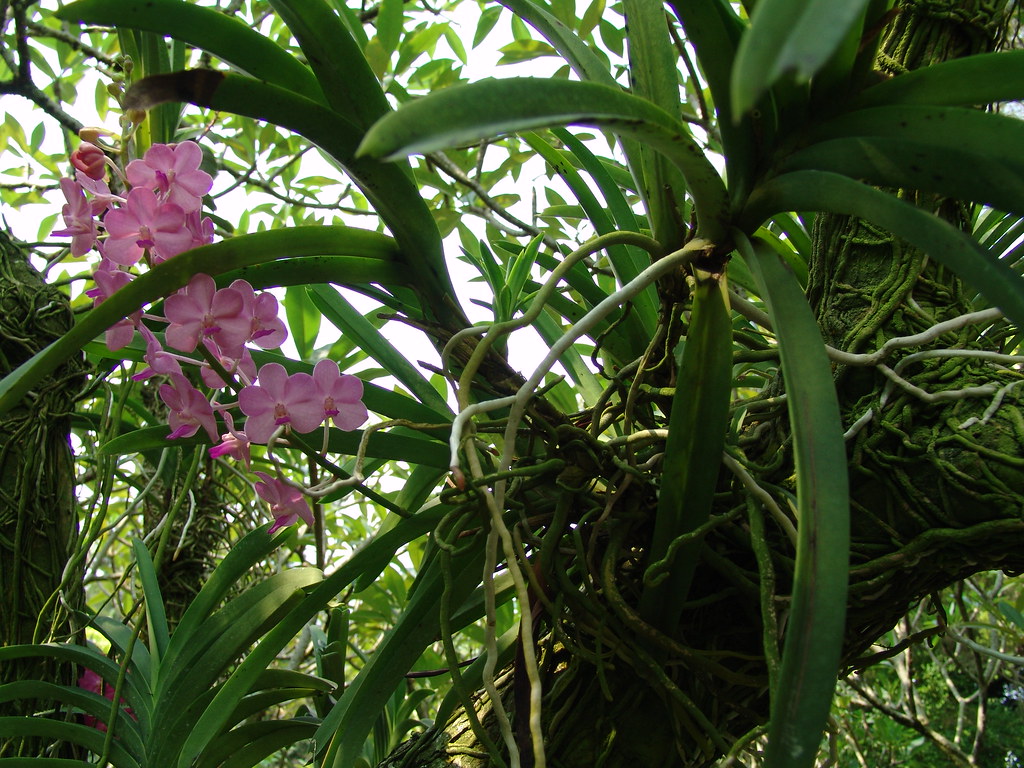To attach an orchid to a tree, use jute, burlap, or plant-based twine that will biodegrade over time. If the plant is heavy, you can also opt for zip ties.
Tighten the ties around the pseudobulb of the orchid and secure it to the tree. Remember to provide proper care for the orchid, especially during the initial months. Growing orchids on trees is a common practice that allows orchids to thrive in a natural environment.
This symbiotic relationship, known as commensalism, benefits the orchid without harming the tree. We will explore the steps on how to attach an orchid to a tree and the various materials you can use for this purpose. We will also provide tips for caring for orchids on trees and answer common questions related to this topic. Whether you are a beginner or an experienced orchid enthusiast, this guide will help you successfully attach and grow orchids on trees.
Choosing The Right Method For Attaching An Orchid To A Tree
When it comes to attaching an orchid to a tree, selecting the right method is crucial for its successful growth and establishment. Understanding different attachment methods, evaluating the weight and size of the orchid, and deciding between plant-based twine or zip ties are important factors to consider. Let’s explore each of these aspects in detail.
Understanding Different Attachment Methods
There are several attachment methods you can choose from when attaching an orchid to a tree. Some common techniques include:
- Using jute, burlap, or another plant-based twine
- Opting for zip ties
- Using glue to secure the orchid to the tree
Each method has its advantages and drawbacks, so it’s essential to assess which one suits your specific needs.
Evaluating The Weight And Size Of The Orchid
The weight and size of the orchid play a significant role in determining the attachment method. It’s crucial to assess the orchid’s weight and growth potential to ensure the chosen attachment method can adequately support it. If the orchid is lightweight, a plant-based twine may be sufficient. However, if the orchid is large or heavy, zip ties may provide more stability.
Deciding Between Plant-based Twine Or Zip Ties
When deciding between plant-based twine or zip ties, there are a few factors to consider. Plant-based twine, such as jute or burlap, offers a sustainable and biodegradable option. It has a high tensile strength that allows it to support the orchid while slowly degrading over time. On the other hand, zip ties provide a more durable and secure attachment, especially for larger and heavier orchids. Ensure that when using zip ties, you fasten them as tight as possible with the pseudobulb off the tree to prevent any damage.
By understanding different attachment methods, evaluating the weight and size of the orchid, and deciding between plant-based twine or zip ties, you can choose the most suitable method for attaching an orchid to a tree. Remember to consider the specific needs of your orchid and ensure a secure and sustainable attachment.
Materials Needed For Attaching An Orchid To A Tree
When it comes to attaching an orchid to a tree, you’ll need a few essential materials to ensure a secure and successful attachment. Below are the materials you’ll need:
Jute, Burlap, Or Plant-based Twine
- Jute
- Burlap
- Plant-Based Twine
These materials are recommended for their high tensile strength and biodegradable properties. They will gradually degrade over time and fall off the tree without causing any harm to the orchid or the environment.
Zip Ties (optional)
- Zip Ties
If you’re dealing with a particularly heavy orchid, you may consider using zip ties as an additional attachment method. Make sure to tighten the zip ties as much as possible, but be careful not to damage the pseudobulb of the orchid.
Glue (optional)
- Glue
In some cases, using a small amount of glue can provide extra stability for the attachment. Apply a dab of glue on the rhizome or pseudobulb of the orchid and hold it against the tree for a few seconds to ensure proper adherence.
Sphagnum Moss
- Sphagnum Moss
Position the orchid on the trunk or branches of the tree and ball up the roots. Then, place sphagnum moss on top of the roots and secure it with plant ties or cotton string. This will provide added support and moisture retention for the orchid.
By using these materials, you’ll be able to securely attach your orchid to a tree, allowing it to thrive in its new environment. Remember to provide adequate care, especially during the first few months after attachment, to ensure the orchid’s successful growth.
Step-by-step Guide: Attaching An Orchid To A Tree Using Twine
To attach an orchid to a tree, use jute, burlap, or plant-based twine with high tensile strength that will biodegrade. Zip ties can be used for heavier plants. Tighten the ties around the tree trunk, ensuring the pseudobulb is off the tree.
Selecting A Healthy And Mature Orchid
Before you can attach an orchid to a tree using twine, it’s important to select a healthy and mature orchid. Look for orchids that have strong, green leaves and are free from any signs of disease or pest infestation. Mature orchids are better suited for attachment, as they have established root systems that can withstand the process.
Preparing The Tree And Orchid For Attachment
To prepare the tree and orchid for attachment, start by identifying a sturdy tree trunk or branch that will provide ample support for the orchid. Ensure that the tree is healthy and free from any signs of rot or decay.
Next, gather your materials. Use a plant-based twine like jute or burlap, as it has a high tensile strength and will biodegrade over time. If the orchid is particularly heavy, you can opt for zip ties instead. Zip your plastic ties on as tight as possible with the pseudobulb off the tree.
Wrapping The Orchid’s Roots With Sphagnum Moss
Once you have selected a healthy orchid and prepared the tree, it’s time to wrap the orchid’s roots with sphagnum moss. This will help to provide moisture and support for the orchid as it establishes itself on the tree.
To do this, gently ball up the roots of the orchid and position the plant on the trunk or branch of the tree. Place a layer of sphagnum moss on top of the roots, ensuring that it is securely in place.
Securing The Orchid To The Tree Trunk Or Branches
Now that the orchid’s roots are wrapped in sphagnum moss, it’s time to secure the orchid to the tree trunk or branches. Take your plant-based twine or zip ties and carefully wrap them around the orchid, making sure to provide enough support without causing any damage to the plant.
Start at the base of the orchid and work your way up, tying the twine or zip ties at regular intervals along the stem. Ensure that the ties are tight enough to hold the orchid in place, but not so tight that they restrict the plant’s growth or circulation.
Maintaining And Caring For The Orchid After Attachment
Once the orchid is securely attached to the tree, it’s important to continue caring for it to ensure its health and longevity. Regularly check the orchid for signs of dehydration or overwatering, and adjust your watering schedule accordingly.
Monitor the orchid for any signs of disease or pest infestation, and take appropriate measures to address these issues if they arise. Additionally, provide the orchid with the necessary nutrients and sunlight it needs to thrive.
By following these steps and providing ongoing care, you can successfully attach an orchid to a tree using twine and enjoy the beauty of these stunning plants as they grow and bloom in their new environment.
Step-by-step Guide: Attaching An Orchid To A Tree Using Zip Ties
If you’ve ever wondered how to attach an orchid to a tree so it can thrive and add beauty to your garden, you’re in the right place. In this step-by-step guide, we will walk you through the process of attaching an orchid to a tree using zip ties. With proper care and attention, you can create a stunning display of orchids blooming on tree trunks or branches. So, let’s get started!
Considering The Weight And Size Of The Orchid
Before attaching an orchid to a tree using zip ties, it’s important to consider the weight and size of the orchid. While zip ties are a secure method, they may not be suitable for larger and heavier orchids. In such cases, it is recommended to use alternative methods like jute, burlap, or another plant-based twine with high tensile strength that will biodegrade and fall off the tree as the orchid grows. However, if you have a smaller or medium-sized orchid, zip ties can work perfectly fine.
Preparing The Orchid And Tree For Attachment
Now that you’ve assessed the weight and size of your orchid, it’s time to prepare the orchid and tree for attachment. Start by selecting a healthy orchid with well-developed roots and pseudobulbs. Ensure that the tree you choose is healthy and sturdy enough to support the weight of the orchid.
Positioning The Orchid On The Tree Trunk Or Branches
To position the orchid on the tree trunk or branches, gently remove any dead or decaying material from the area where you plan to attach the orchid. This will provide a clean surface for attachment and help prevent any potential damage to the orchid or tree. Once the area is clean, place the orchid against the tree trunk or branch, ensuring that it is in a position where it can receive adequate sunlight and airflow.
Fastening The Orchid With Zip Ties
Now it’s time to fasten the orchid securely to the tree using zip ties. Start by wrapping a zip tie around the orchid’s pot or base, making sure it is tight but not too tight to damage the plant. Then, carefully wrap the zip tie around the tree trunk or branch, ensuring that it is secure and the orchid is held firmly in place. Repeat this process with additional zip ties as needed, spacing them out evenly to provide optimal support for the orchid.
Post-attachment Care For The Orchid
Once you have successfully attached the orchid to the tree using zip ties, it’s important to provide the necessary care to ensure its growth and health. Regularly monitor the orchid for any signs of stress or damage, such as wilting or yellowing leaves. Water the orchid as needed, ensuring that the roots receive adequate moisture without becoming too saturated. Additionally, provide appropriate fertilization and pruning to promote healthy growth and blooming. With proper care and attention, your orchid will thrive and add beauty to the tree.
Ensuring The Longevity And Success Of Orchid Attachment
Attaching an orchid to a tree can be a beautiful way to display these stunning plants. However, it’s important to ensure the longevity and success of the orchid attachment. Follow these steps to monitor the orchid’s health and growth, provide proper watering and nutrients, and protect the orchid from harsh weather conditions.
Monitoring The Orchid’s Health And Growth After Attachment
Once you have attached the orchid to a tree, it is crucial to monitor its health and growth regularly. Pay attention to the following indicators:
- Check for any signs of pests or diseases. If you notice any, take immediate action to prevent further damage.
- Keep an eye on the leaves and flowers. If they start to wilt or turn yellow, it may be an indication of insufficient water or poor light conditions.
- Observe the growth of new shoots and roots. This indicates that the orchid is thriving and adapting to its new environment.
Providing Proper Watering And Nutrients
Watering and providing nutrients are essential for the success of an orchid attached to a tree. Follow these guidelines:
- Water the orchid regularly, ensuring the roots receive enough moisture without becoming waterlogged.
- Use a well-draining medium, such as a bark-based orchid mix, to prevent water accumulation around the roots.
- Fertilize the orchid with a balanced orchid fertilizer according to the manufacturer’s instructions. This will provide the necessary nutrients for healthy growth.
Protecting The Orchid From Harsh Weather Conditions
Harsh weather conditions can have a negative impact on the health of an orchid attached to a tree. Take the following precautions:
- Shield the orchid from direct sunlight if it is too intense. Orchids prefer filtered or indirect light.
- During cold weather, consider providing additional insulation, such as wrapping the orchid with burlap or a frost cloth, to protect it from freezing temperatures.
- During heavy rain or strong winds, check the attachment to ensure it is secure. Reinforce the ties if necessary to prevent the orchid from getting dislodged.
By monitoring the orchid’s health, providing proper watering and nutrients, and protecting it from harsh weather conditions, you can ensure the longevity and success of an orchid attached to a tree. Enjoy the beauty of your orchid as it thrives in its new habitat!
Frequently Asked Questions Of How Do You Attach An Orchid To A Tree
How Do Orchids Get Along With Trees?
Orchids and trees have a symbiotic relationship called commensalism. Orchids benefit from trees by obtaining nutrients from them, while the trees remain unaffected. Orchids can be attached to trees using jute, burlap, or plant-based twine, or by using zip ties for heavier plants.
How Do You Tie An Orchid To A Palm Tree?
To tie an orchid to a palm tree, use jute, burlap, or a plant-based twine with high tensile strength. Wrap the twine around the orchid and tree, ensuring it’s secure. For heavier plants, zip ties can be used. Tighten the zip ties as much as possible, keeping the pseudobulb off the tree.
What Does The Orchid Do To The Tree?
Orchids show a symbiotic relationship with trees, known as commensalism. Orchids get their nutrition from trees without causing harm, while trees do not receive any benefits from orchids. This relationship is healthy and does not negatively impact the trees. Orchids growing on tree branches is an example of this commensalism.
How Do You Attach An Orchid To A Tree?
To attach an orchid to a tree, use jute, burlap, or another plant-based twine that has a high tensile strength. Alternatively, you can use zip ties if the plant is heavy. Attach the twine or ties as tight as possible and ensure the pseudobulb is off the tree for better attachment.
Conclusion
Attaching an orchid to a tree can be done easily with the right materials. Use jute, burlap, or a plant-based twine with high tensile strength that will biodegrade over time. If the plant is heavy, opt for zip ties. Remember to tighten them as much as possible and remove the pseudobulb from the tree.
By following these steps, you can successfully attach your orchid to a tree and enjoy its beautiful growth.







 Dr Ahsanur Rahman, PHD
Dr Ahsanur Rahman, PHD



